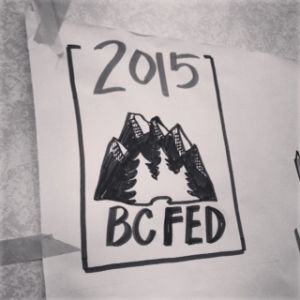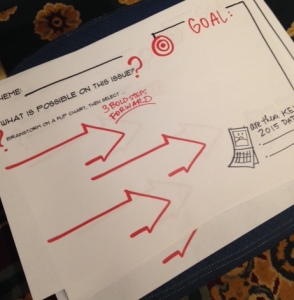Visual Facilitation with Templates
 Busy people in leadership positions need meetings that work. Visual templates help groups get focussed, fast.
Busy people in leadership positions need meetings that work. Visual templates help groups get focussed, fast.
This week, Kevin Millsip (from Next Up) and I co-facilitated a 2.5 day meeting for the BC Federation of Labour.
Kevin and I used Visual Facilitation with templates to structure the strategic planning. At the end of the session, someone said to me, “you know, it’s been 2 and a half days and I’m not tired.” That’s exactly what we want to hear. I think it’s partly because templates make the time go by effectively.
 I like templates because they help groups stay on track. Everyone can see what steps still need to be done. And the large format keeps peoples’ attention, too. People need to collaborate to fill it in, together – and so the leadership in the small group can be shared. I encourage you to draw your own on a flip chart: you can mix and match these elements on your own template to make a SWOT concept work for you. Maybe you don’t need to talk about “problems” until later, for example. Maybe you need to go deeper into allies/potential supporters. It’s flexible.
I like templates because they help groups stay on track. Everyone can see what steps still need to be done. And the large format keeps peoples’ attention, too. People need to collaborate to fill it in, together – and so the leadership in the small group can be shared. I encourage you to draw your own on a flip chart: you can mix and match these elements on your own template to make a SWOT concept work for you. Maybe you don’t need to talk about “problems” until later, for example. Maybe you need to go deeper into allies/potential supporters. It’s flexible.
Here’s two examples and how they were used differently.
 This first visual template was 4 foot by 4 foot. (Here it’s drawn on an Ipad to show you the style.) I drew 8 of these, one for each group. Why so big? Lots of room for people to get their ideas out. Big-picture brainstorming.
This first visual template was 4 foot by 4 foot. (Here it’s drawn on an Ipad to show you the style.) I drew 8 of these, one for each group. Why so big? Lots of room for people to get their ideas out. Big-picture brainstorming.
The second visual template is placemat sized. For this activity, participants needed to prioritize and focus next steps. So the brainstorming happened on a flip chart and the ideas were copied into this template. The template helped focus the discussion, and also the report-out.
The added benefit of the consistent report-out structure helped me with the graphic recording, too. I could seamlessly listen to each group give us their “three bold steps”.
Hope you add visual templates to an upcoming meeting – just one more visual tool for your toolbox!